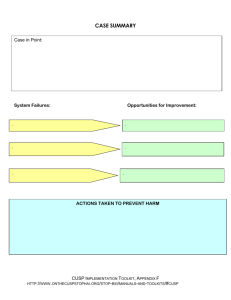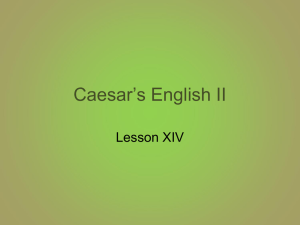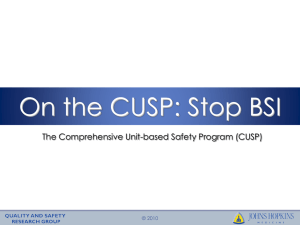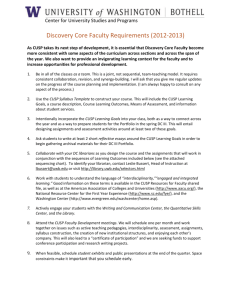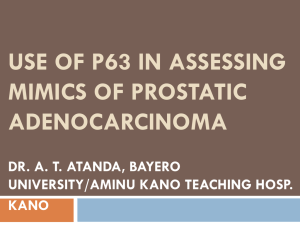3.3. Revised coding in Necrolestes and Cronopio
advertisement
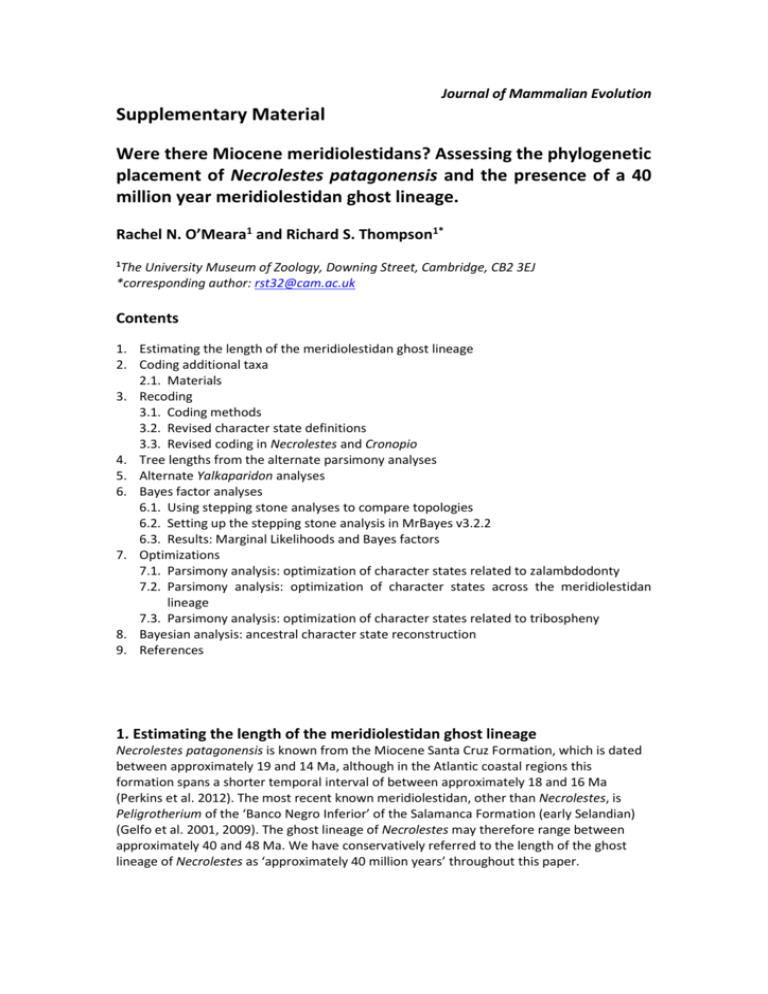
Journal of Mammalian Evolution Supplementary Material Were there Miocene meridiolestidans? Assessing the phylogenetic placement of Necrolestes patagonensis and the presence of a 40 million year meridiolestidan ghost lineage. Rachel N. O’Meara1 and Richard S. Thompson1* 1 The University Museum of Zoology, Downing Street, Cambridge, CB2 3EJ *corresponding author: rst32@cam.ac.uk Contents 1. Estimating the length of the meridiolestidan ghost lineage 2. Coding additional taxa 2.1. Materials 3. Recoding 3.1. Coding methods 3.2. Revised character state definitions 3.3. Revised coding in Necrolestes and Cronopio 4. Tree lengths from the alternate parsimony analyses 5. Alternate Yalkaparidon analyses 6. Bayes factor analyses 6.1. Using stepping stone analyses to compare topologies 6.2. Setting up the stepping stone analysis in MrBayes v3.2.2 6.3. Results: Marginal Likelihoods and Bayes factors 7. Optimizations 7.1. Parsimony analysis: optimization of character states related to zalambdodonty 7.2. Parsimony analysis: optimization of character states across the meridiolestidan lineage 7.3. Parsimony analysis: optimization of character states related to tribospheny 8. Bayesian analysis: ancestral character state reconstruction 9. References 1. Estimating the length of the meridiolestidan ghost lineage Necrolestes patagonensis is known from the Miocene Santa Cruz Formation, which is dated between approximately 19 and 14 Ma, although in the Atlantic coastal regions this formation spans a shorter temporal interval of between approximately 18 and 16 Ma (Perkins et al. 2012). The most recent known meridiolestidan, other than Necrolestes, is Peligrotherium of the ‘Banco Negro Inferior’ of the Salamanca Formation (early Selandian) (Gelfo et al. 2001, 2009). The ghost lineage of Necrolestes may therefore range between approximately 40 and 48 Ma. We have conservatively referred to the length of the ghost lineage of Necrolestes as ‘approximately 40 million years’ throughout this paper. 2. Coding additional taxa The phylogenetic analysis of Rougier et al. (2012) was expanded to include three additional taxa: Notoryctes typhlops, Naraboryctes philcreaseri, and Yalkaparidon (coded as composite of Y. coheni and Y. jonesi). 2.1. Materials: Notoryctes typhlops material: UMZC A5.1/1 - Complete postcranium. Skull with damage to right auditory bulla. Jaw with complete dentition. UMZC A5.1/5 – Skull with jaw, but missing zygomatic arches and with damage to both auditory bullae. Dentition incomplete: missing right ultimate premolar and right first molar. AMNH 202107 - Animated 3D renderings and ‘dynamic cutaway’ views of complete skull and jaw from Digital Morphology website, University of Texas, Austin (Rodgers 2008). Further information for coding Notoryctes characters was provided by figures and text from the following publications: Szalay (1994); Long et al. (2002); Asher and Sánchez-Villagra (2005); Asher et al. (2007); Ladevèze et al. (2008); Ungar (2010). In particular, figures of CT scans of a Notoryctes petrosal from Ladevèze et al. (2008) were used in coding petrosal characters. Naraboryctes philcreaseri material: Coded from figures and text of Archer et al. (2011). Naraboryctes is known from two left dentaries, fragments of maxilla, upper and lower dentition, a left humerus, and a left ulna. Yalkaparidon material: The character states of Yalkaparidon used in the main analyses of the manuscript are coded from figures and text of Archer et al. (1988), Beck (2009) as the most detailed peer reviewed published articles on this taxon at the start of the project. Most coding of palatal, orbital, zygomatic, mandibular, and dental characters was taken from images of a skull and its associated dentary, and of upper and lower molars of Yalkaparidon coheni. An image of a right dentary and third lower premolar of Yalkaparidon jonesi was also used (Archer et al. 1988). Some maxillary characters and characters relating to the upper dentition were coded using images of isolated maxillae referred to Yalkaparidon sp. (Beck 2009). Alternate codings are also presented, which account for the novel interpretations of Yalkaparidon in Beck et al. (2013). Beck et al. (2013) revised the interpretation of the dental formula of Yalkaparidon, identifying a single premolar (P3) and four molars (contra Archer 1988). Furthermore, they suggested uncertainty over the identity of the distolingual lower molar cusp, raising the possibility that this represents the remnant of a talonid basin rather than a metaconid. This latter hypothesis is tested in a separate analysis. Our alternative codings of Yalkaparidon can be found in our nexus file, along with variants of all three codings (Archer 1988 and two alternatives from Beck et al. 2013), which incorporate uncertainty over the identity of the primary lingual cusp of Yalkaparidon. The names of the taxa in the nexus file are explained below. Yalkaparidon_met_Archer – Coded following Archer et al. (1988) and Beck (2009) with metacone zalambdodonty. Yalkaparidon_uncertain_Archer - Coded following Archer et al. (1988) and Beck (2009) with uncertain zalambdodonty. Yalkaparidon_met_Beck - Coded following Beck et al.’s (2013) dental formula with metacone zalambdodonty. Yalkaparidon_uncertain_Beck - Coded following Beck et al.’s (2013) dental formula with uncertain zalambdodonty Yalkaparidon_met_Becktalonid - Coded following Beck et al.’s (2013) dental formula with metacone zalambdodonty and interpreting the distolingual lower molar cusp as vestigial talonid basin. Yalkaparidon_uncertain_Becktalonid - Coded following Beck et al.’s (2013) dental formula with uncertain zalambdodonty and interpreting the distolingual lower molar cusp as vestigial talonid basin. The results of these alternate analyses are detailed in Section 5. 3. Recoding 3.1. Coding Methods Throughout, we have followed the coding strategy of Rougier et al. (2012) as faithfully as possible in order to maintain the consistency of the analysis. As regards the coding of inapplicable and unknown character states, we note that in the original Rougier et al. (2012) matrix, there are several instances where one character state is dependent on the presence of another character. For example, character 90: (90. Entoconid. (0) absent (1) present, but far from hypoconulid, at least equal to one cusp length (2) present and twinned with hypoconulid.) …is dependent on character 85: (85. Talonid Basin. (0) Absent. (1) Present). If character 85 is coded as absent (0), then logically, character 90 should be coded as inapplicable (-): the entoconid is a talonid cusp, and is not recorded without the presence of a fully basined talonid. However, under the Rougier et al. (2012) coding strategy, the entoconid is scored as absent, effectively up-weighting the absence of the talonid in the analysis. We have followed this original coding strategy in these instances. We are acutely aware of the difficulties of assigning tooth cusp homologies across Mesozoic mammaliaforms, particularly those distal cusps that could be associated with the talonid. It would be interesting to recode the entire matrix to account for the contingency of these characters, so as to prevent up-weighting the absence of certain features such as the talonid basin, although this is clearly a complex endeavor. When coding additional taxa by the Rougier et al. (2012) character list, it was assumed that when tooth cusp identity is designated by letter, rather than by name, that this refers to the relative position of the cusp, rather than its strict homology, e.g. ‘cusp a’ indicates the labialmost cusp of the trigonid of the lower molar rather than a cusp homologous with the protoconid. Character 113 (see below for example) would be coded as (1) in both paracone- and metacone zalambdodonts since ‘upper primary cusp b’ refers to a cusp in the same relative position in both forms of zalambdodonty, rather than strictly to the paracone. 113. Topographic Relationships of Wear Facets to Main Cusps. (0) Lower cusps a and c support two different wear facet (1 and 4) that contact the upper main cusp a. (1) Lower cusps a and c support a single wear facet (4) that contacts the upper primary cusp b. However, if a cusp is designated solely by name, and not by letter, then it was assumed that this refers to its homology, and not its relative position. Thus, character 130 (Metacone. 0 = Present; 1 = Absent) would be coded (1) if Necrolestes is a paracone zalambdodont and (0) if it is a metacone zalambdodont. Archer et al. (1988) stated that: “…although Yalkaparidon molars are zalambdodont there is no trace of… paraconids, metaconids or stylar cusps that are prominent features in molars of Notoryctes”, but that the lower molars “…have [a] single large lingual cusp which we interpret as [the] protoconid from which emanate two lingually directed crests. Although the corners at which these crests terminate could be homologs of paraconid and metaconid, they do not form discrete cusps.” However, the protoconid and the two lingually directed crests are the only prominent eminences of the lower molar of Yalkaparidon and occupy the same relative positions as the protoconid, paraconid, and metaconid in most therians. Since character definitions relating to the trigonid cusps are phrased by designating cusps by letter (i.e., by relative position) rather than by name (i.e., by homology), the mesio-lingual and disto-lingual crests and the labial cusp of the lower molars of Yalkaparidon have been coded, in the main analysis, as if they were the paraconid, metaconid, and protoconid respectively. Alternative codings for the lower molar cusps of Yalkaparidon are explored in the analyses “Yalkaparidon_uncertain_Becktalonid” and “Yalkaparidon_met_Becktalonid” in order to investigate the possible alternative lower cusp homologies suggested by Beck et al. (2013). 3.2. Revised character state definitions Some character definitions required revision in order to accommodate new taxa or the assumption of a different form of zalambdodonty within the existing list of character states. Original character definitions from Rougier et al. (2012) are shown in regular typeface below, with revisions shown in red. Each character statement is discussed in italics, after its definition. 2. Position of the posteriormost mental foramen. (0) Below the canine and anterior premolariform region. (1) Below the penultimate premolar. (2) Below the ultimate premolar. (3) Posterior to the ultimate premolar. Revised character state 3 definition since, in Yalkaparidon, the posteriormost mental foramen is situated below the second molar, not between the ultimate premolar and the first molar as indicated by the previous character state. 115. Upper molar—development of facet 1 and preprotocrista (or paracrista, or premetacrista) on upper molars. (0) Facet 1 (prevallum crest) is short, and does not extend to the stylocone area. (1) Wear facet 1 extends beyond into the hook-like area near the stylocone. (2) Long preprotocrista (or paracrista or premetacrista) is added to the prevallum shear and extends labially beyond paracone (or metacone in metacone zalambdodonts). Revised character definition to accommodate different forms of zalambdodonty. Original coding for Necrolestes (1) and Cronopio (1) retained when assuming metacone zalambdodonty. 285. Maximum vertical depth of zygomatic arch relative to length of skull (0) Between 10% and 20%. (1) Between 5% and 7%. Maximum vertical depth of zygomatic arch relative to length of skull is 7.6% and 8.1% for Notoryctes and Yalkaparidon respectively. Since both these values are closer to 7% than 10%, both species are coded (1) and the character state definitions redefined to: (0) Between 8.5% and 20%. (1) Between 5% and 8.5%. 3.3. Revised coding in Necrolestes and Cronopio Characters were recoded in two different ways, assuming either that the lingual-most cusp of the upper molars of Necrolestes and Cronopio is the metacone (metacone zalambdodonty) or that the identity of this cusp is uncertain (uncertain zalambdodonty). Ten characters were recoded under the assumption of metacone zalambdodonty; these changes are described individually below. Under the assumption of uncertain zalambdodonty these characters were recoded as (?) unless otherwise stated. 58. Development of postprotocrista on upper molars for double rank postvallum shear. (0) Postprotocrista is short and does not extend labially beyond the metacone. (1) Postprotocrista is long and extends labially beyond the metacone. Assuming metacone zalambdodonty in Necrolestes and Cronopio, both protocone and postprotocrista absent in upper molars. Coding in Necrolestes and Cronopio therefore revised to inapplicable (-). 102. Relative height and size of paracone (cusp b) and metacone of upper molars. (0) Paracone higher and larger than metacone. (1) Metacone is higher and larger than paracone. Assuming metacone zalambdodonty in Necrolestes and Cronopio, the most lingual cusp is the metacone, and the paracone is absent. Coding in both species therefore revised to (1). 122. Bifid metastyle. (0) Absent. (1) Present. The identity of the metastyle is ambiguous if metacone zalambdodonty is assumed in Cronopio. Coding in Cronopio is therefore revised to (?). 125. Position of stylocone in posterior molariforms. (0) Along buccal edge. (1) Separated. The identity of the stylocone is ambiguous if metacone zalambdodonty is assumed in Necrolestes and Cronopio. Coding in both species is therefore revised to (?). 126. Stylocone relationship in triangular teeth. (0) Stylocone connected to paracrista or mesial to its end. (1) Stylocone distal to labial ending of paracrista. (2) Stylocone detached of preparacrista occupying central position on crown. The identity of the stylocone is ambiguous if metacone zalambdodonty is assumed in Necrolestes and Cronopio. Coding in both species is therefore revised to (?). 127. Stylocone size in triangular teeth. (0) Absent. (1) Small stylar cusp. (2) Prominent cusp subequal or larger than paracone. The identity of the stylocone is ambiguous if metacone zalambdodonty is assumed in Necrolestes and Cronopio. Coding in both species is therefore revised to (?). 129. Paracone orientation. (0) Erect. (1) Recumbent. (2) Procumbent. Assuming metacone zalambdodonty in Necrolestes and Cronopio, the most lingual cusp is the metacone, and the paracone is absent. Coding in both species therefore revised to inapplicable (-). 130. Metacone. (0) Present. (1) Absent. Assuming metacone zalambdodonty in Necrolestes and Cronopio, the most lingual cusp is the metacone, and the paracone is absent. Coding in both species therefore revised to (0). 131. Paracone-metacone labiolingually aligned. Consider only in subtriangular upper teeth: (0) Absent, the metacone is labial to paracone. (1) Present, the metacone is approximately aligned mesiodistally with the paracone. Assuming metacone zalambdodonty in Necrolestes and Cronopio, the most lingual cusp is the metacone, and the paracone is absent. Coding in both species therefore revised to inapplicable (-). 147. Position of lingual upper root. (0) Under paracone. (1) Under protocone or trigon. (2) Under metacone. If metacone zalambdodonty is assumed in Necrolestes and Cronopio, the lingual upper root is positioned under the metacone, requiring addition of character state 2. Coding in Necrolestes and Cronopio revised to new character state: (2) Under metacone. If uncertain zalambdodonty is assumed, the lingual root could be positioned under either the paracone or the metacone, but not under the protocone or trigon. Coding was, therefore, revised to (0,2) in the case of uncertain zalambdodonty. 4. Tree lengths from the alternate parsimony analyses Rougier et al. (2012) l = 1154 Including Cronopio Without Cronopio Including new metatherians Without new metatherians 1242 1153 1239 1150 1221 1132 1218 1129 Metacone zalambdodonty Uncertain zalambdodonty Metacone zalambdodonty Uncertain zalambdodonty 5. Alternate Yalkaparidon analyses Coding strategy Following Archer et al. (1988) and Beck (2009) Following Beck (2008) Following Beck’s (2008) talonid retention hypothesis Metacone zalambdodont TL MPT Topology Uncertain zalambdodont TL MPT Topology 1242 37 Fig 1 1242 38 Identical to Fig 1. 1246 66 Collapse nodes 49 & 50 of Fig 1. 1246 62 Collapse nodes 49 & 50 of Fig 1. 1241 60 Collapse nodes 49 & 50 of Fig 1. 1244 60 Collapse nodes 49 & 50 of Fig 1. The a priori assumptions of primary lingual cusp homology in Yalkaparidon do not affect its phylogenetic placement in this dataset, and only affect tree length if we assume the presence of a vestigial talonid on the lower molars. Variant interpretations of Yalkaparidon only serve to lessen resolution, but do not otherwise impact upon the tree. 6. Bayes factor analyses 6.1. Using stepping stone analyses to compare topologies Bayes factors are calculated from the marginal likelihood, which was estimated here using stepping stone analyses. In order to compare different hypotheses for the placement of both Necrolestes and the Australosphenida, it was necessary to impose constraints upon our analyses. By applying constraints to a Bayesian analysis, the amount of tree space available to search is reduced by the prior on tree topology. This means that the posterior probability, and thus marginal likelihood, of a constrained topology will be higher than an unconstrained one, simply because there are fewer potential topological outcomes. Therefore, in order to make a fair comparison of two different topological hypotheses, the tree should be fixed in both instances, so that both analyses have a single possible topological outcome. If the model used for each analysis is then identical, apart from the fixed topologies, the marginal likelihoods should be comparable, and Bayes factors meaningful. In order to perform such comparisons between the hypothesis that Necrolestes is a meridiolestidan vs. the hypothesis that Necrolestes is a metatherian, and the different hypotheses for the placement of Australosphenida, it was therefore essential to establish a fully resolved topology. The topologies used for each analysis are detailed below: Meridiolestidan Necrolestes: The most likely topology (found in the TreeProbs file) sampled during an unconstrained Bayesian analysis was used as the fully resolved fixed topology for a stepping stone analysis. This was consistent with the majority rule consensus tree presented in Figure 3. Metatherian Necrolestes: A Bayesian analysis was performed in which Necrolestes was constrained to the Metatheria. The most likely topology (found in the TreeProbs file) sampled during this analysis was used as the fully resolved fixed topology for a stepping stone analysis. Bayesian placement of the Australosphenida: The most likely topology (found in the TreeProbs file) sampled during an unconstrained Bayesian analysis was used as the fully resolved fixed topology for a stepping stone analysis. This was consistent with the majority rule consensus tree presented in Fig. 3. Parsimony placement of the Australosphenida: One of the 37 MPTs produced from a parsimony analysis of the dataset (Fig. 1) was used as the fixed topology in this analysis. 6.2. Setting up the stepping stone analysis in MrBayes v3.2.2 Analyses used 31 million generations, with a sample frequency of 1000. The stepping stone burnin was set to 1000 samples, producing a burnin run of 1,000,000 generations, sufficient for all runs to reach convergence in the independent analyses. The stepping stone analysis took 40 steps, meaning that each step lasted 750,000 generations. The settings are shown below. Mcmcp ngen=31000000 temp=0.25 samplefreq=1000; ssp burninss=1000 nsteps=40; 6.3. Results: Marginal Likelihoods and Bayes factors Model testing: Table of Marginal likelihoods Model Run 1 Run 2 MK+G -5052.65 -5052.51 MK -5126.06 -5127.67 Table of Bayes factors (expressed as their natural logarithm) MK+G run 1 MK+G run 2 MK run 1 MK run 2 MK+G run 1 0.14 73.41 75.02 MK+G run 2 73.55 75.16 MK run 1 1.61 MK run 2 Note that Bayes factors are reported in the manuscript as twice the natural logarithm. Hypothesis testing: Table of Marginal likelihoods Topology Run 1 Run 2 Unconstrained -4668.18 -4668.19 Metatherian -4907.81 -4907.95 Parsimony -4869.75 -4869.68 Table of Bayes factors (expressed as their natural logarithm) Uncon. Uncon. Meta. Meta. Pars. run 1 run 2 run 1 run 2 run 1 Unconstrained run 1 -0.01 239.63 239.62 201.57 Unconstrained run 2 239.77 239.76 201.5 Metatherian run 1 0.14 -38.06 Metatherian run 2 -38.2 Parsimony run 1 - Pars. run 2 201.56 201.49 -38.13 -38.27 -0.07 Parsimony run 2 - - - - - - Note that Bayes factors are reported in the manuscript as twice the natural logarithm. 7. Optimizations 7.1. Parsimony analysis: optimization of character states related to zalambdodonty This table shows unambiguous optimization of character states related to zalambdodonty (described in Section 3.3) across nodes A to D of the parsimony topology assuming uncertain zalambdodonty (topology and node numbering identical to Fig. 1). In some cases, where unambiguous optimization to a particular node could not be obtained, ACCTRAN and DELTRAN node optimizations are given. These are marked * and presented in the format ACCTRAN/DELTRAN. These optimizations suggest that loss of the metacone unites all taxa of Node B, and hence, is consistent with the hypothesis that Necrolestes is paracone zalambdodont. Character State Node 58 No optimizations for this character state across nodes A to D - 102 122 125 126 127 129 130 131 147 No optimizations for this character state across nodes A to D 0 - Bifid metastyle absent 1 - Stylocone positioned along buccal edge of posterior molariform 2 - Stylocone detached of preparacrista occupying central position on crown 2 - Stylocone subequal or larger than paracone No optimizations for this character state across nodes A to D 1 - Metacone absent No optimizations for this character state across nodes A to D No optimizations for this character state across nodes A to D C/Leonardus* A B/B* B B - 7.2. Parsimony analysis: optimization of character states across the meridiolestidan lineage This table shows unambiguous optimization of all character states (dental and non-dental) across nodes A to D (Fig. 2) of the parsimony topology, assuming metacone zalambdodonty in both Necrolestes and Cronopio. Additional characters optimized at these nodes by ACCTRAN and DELTRAN optimization are also shown. Those characters which optimize across these nodes in both ACCTRAN and DELTRAN optimization are highlighted in red and blue for non-dental and dental characters, respectively. Meridiolestidan Node (Fig. 2) A Non-dental Characters Unambiguous Optimization 17:1; 5:2; 218:0; 285:0 Dental Characters 46:1; 55:2; 108:1; 125:1 42:1; 48:1; 55:1; 60:2; 81:0; 82:1; 86:0; 111:1; 127:2; 137:1 Non-dental Characters 1:0; 12:1; 171:1; 181:0; 188:0; 201:0; 219:0; 223:0; 247:1; 250:1; 262:1; 281:0; 291:1; 303:0 1:1; 2:1; Dental Characters 93:2; 106:1; 126:1; 140:1 34:1; 47:0; 52:2; 93:0; 126:2; 130:1; 152:1 ACCTRAN Optimization DELTRAN Optimization B 78:2; 108:2; 153:1; 154:1 9:3; 23:1; 246:0; 273:0; 288:1; 289:2; 296:0; 299:2 41:1; 122:0; 136:2; 139:1; 146:0; 156:1 12:1; 231:2; 247:1; 250:1; 312:1 Non-dental Characters Dental Characters C 76:0; 120:2; 123:1; 141:0 126:2; 47:0; 52:2; 140:1; 152:1 D 102:1; 134:0; 135:0; 147:2 2:0; 106:0; 130:0 9:3; 226:1; 246:0; 291:1; 299:2 41:1; 136:2; 139:1; 146:0 7.3. Parsimony analysis: optimization of character states related to tribospheny This table shows unambiguous optimization of character states related to the acquisition of tribospheny across our parsimony topology (see Fig 1). The node at which each particular character state optimizes is presented. We found that none of these characters optimize basal to the Australosphenida-Boreosphenida divergence, which is consistent with independent acquisition of tribospheny in these two lineages. Therefore, the optimized characters are presented in two columns, representing the separate acquisition of tribospheny in the boreosphenidan and australosphenidan lineages. Where unambiguous optimization to a particular node could not be obtained, ACCTRAN and DELTRAN node optimizations are given. These are marked * and presented in the format ACCTRAN/DELTRAN. Stem and Crown Australosphenida Stem and Crown Boreosphenida Character State 60 64 65 3 - Part of the talonid occludes with the lingual face of the upper molar 1 - Cristid obliqua present 2 - Cristid obliqua short and pointed anteriorly between metaconidprotoconid notch and the protoconid. - 66 1 - Talonid pre-entocristid crest is in alignment with the metaconid or with the postmetacristid if the latter is present 83 1 - Molar trigonid/talonid width ratio: wide (talonid is 40 - 70% of trigonid) 84 85 86 87 88 89 90 2 - Talonid is equal or wider than trigonid (over 70% of width of trigonid) 1 - Lower molar hypoflexid deep (but less than 50% of talonid width) Node 31 40 State 3 - Part of the talonid occludes with the lingual face of the upper molar 1 - Cristid obliqua present Node 16 16 48 1 - Cristid obliqua hypertrophied and directed to posterior part of metaconid 19/21* - 2 - Cristid obliqua short and pointed anteriorly between metaconid-protoconid notch and the protoconid. 20/20* 43 2 - Talonid pre-entocristid crest is offset from the metaconid and is lingual to the base of the metaconid 16 42 2 - Talonid is equal or wider than the trigonid (above 70% of the width of the trigonid) 16 48 - - 40 - - 1 - Talonid basin present 2 - Rear portion of molariform present as a heel (with at least one functional cusp) 4 - Rear portion of molariform rimmed with three major cusps 1 - Hypoconulid (=cusp d) is elevated above the cingulid level 1 - Hypoconid present 1 - Hypoconulid cusp tip recumbent 1 - Entoconid present but far from hypoconulid 42 1 - Lower molar hypoflexid deep (but less than 50% of talonid width) 2 - Very deep (>60% of talonid width) 1 - Talonid basin present 16 21 16 31 3 - Present as a transverse V-shaped basin with two major cusps 21 43 - - 1 - Hypoconulid (=cusp d) is 40 elevated above the cingulid level 40 1 - Hypoconid present Character not optimized in 44/44* this lineage 1 - Entoconid present but 44 far from hypoconulid 15 16 16/17* 91 92 93 94 97 98 99 100 116 118 124 1 - Entoconid height subequal to the hypoconulid 1 - Paraconid, metaconid and entoconid aligned 2 - Aspect ratio in occlusal view of functional talonid basin: wider than long 1Hypoconulid/protoconid height ratio between 25% and 35% Character not optimized in this lineage 1 - Functional lingual protocone that grinds against basin on lowers present Character not optimized in this lineage 1 - Distance from protocone apex >0.60 of total width 1 - Moderate development of lingual region of upper molars 1 - Differentiation of wear facet 3 and wear facet 4 present Wear pattern on talonid present Character not optimized in this lineage 2 - Present and twinned with hypoconulid 1 - Entoconid height 44 subequal to the hypoconulid 1 - Paraconid, metaconid 47 and entoconid aligned 2 - Aspect ratio in occlusal 48/50* view of functional talonid basin: wider than long 20/20* 19/20* 19/20* 15 40 1 - Hypoconulid/protoconid height ratio between 25% and 35% 16 - 3 - Hypoconulid/protoconid height ratio: 50% or higher 19 42 Character not optimized in this lineage - - Character not optimized in this lineage - 45 Character not optimized in this lineage - 45 Character not optimized in this lineage - 40 43 - 1 - Differentiation of wear facet 3 and wear facet 4 present Character not optimized in this lineage 1 - Multiple ridges within talonid basin 16 20 10. Bayesian analysis: ancestral character state reconstruction These tables show reconstruction of ancestral character states related to acquisition of tribospheny at each of four nodes (W, X, Y, and Z) in our Bayesian topology (Fig. 3). Where reconstructed character states differ from those at Node W, these are shown in red. Node W Character Reconstructed Description State 60 3 64 1 65 0 66 0 83 0 84 1 85 Equivocal 86 2 87 88 89 1 1 Equivocal 90 Equivocal 91 Equivocal 92 Equivocal 93 Equivocal 94 1 97 0 98 99 Equivocal 0 100 Equivocal 116 118 123 124 130 1 0 0 0 0 Part of the talonid occludes with the lingual face (or any part) of the upper molar) Cristid obliqua present Orientated to or lingual to the metaconid-protoconid notch Talonid lacks medial and longitudinal crest Molar trigonid/talonid width ratio: narrow or absent (talonid <40 % of trigonid) Lower molar hypoflexid deep (but less than 50% of talonid width) Talonid basin presence equivocal Rear portion of molariform present as a heel (with at least one functional cusp) Hypoconulid (=cusp d) is elevated above the cingulid level Hypoconid present Hypoconulid orientation is equivocal Entoconid presence and/or distance from hypoconulid is equivocal Height of entoconid in comparison with other talonid cusps is equivocal Alignment of paraconid, metaconid and entoconid is equivocal Aspect ratio in occlusal view of functional talonid basin is equivocal Hypoconulid/protoconid height ratio between 25% and 35% Functional lingual protocone that grinds against basin on lowers absent Trigon basin presence is equivocal Transverse width of protocone narrow Anteroposterior development of lingual region of upper molars is equivocal Differentiation of wear facet 3 and wear facet 4 present Wear pattern on talonid absent Distal metacristid present Smooth surface on the talonid (or on cusp d) Metacone present Node X Character Reconstructed Description State 60 3 64 1 65 0 66 83 0 Equivocal 84 1 85 Equivocal 86 2 87 88 89 1 1 Equivocal 90 Equivocal 91 Equivocal 92 Equivocal 93 Equivocal 94 1 97 1 98 99 1 0 100 Equivocal 116 118 123 124 130 1 0 0 0 0 Part of the talonid occludes with the lingual face (or any part) of the upper molar) Cristid obliqua present Orientated to or lingual to the metaconid-protoconid notch Talonid lacks medial and longitudinal crest Molar trigonid/talonid width ratio equivocal Lower molar hypoflexid deep (but less than 50% of talonid width) Talonid basin presence equivocal Rear portion of molariform present as a heel (with at least one functional cusp) Hypoconulid (=cusp d) is elevated above the cingulid level Hypoconid present Hypoconulid orientation is equivocal Entoconid presence and/or distance from hypoconulid is equivocal Height of entoconid in comparison with other talonid cusps is equivocal Alignment of paraconid, metaconid and entoconid is equivocal Aspect ratio in occlusal view of functional talonid basin is equivocal Hypoconulid/protoconid height ratio between 25% and 35% Functional lingual protocone that grinds against basin on lowers present Trigon basin present Transverse width of protocone narrow Anteroposterior development of lingual region of upper molars is equivocal Differentiation of wear facet 3 and wear facet 4 present Wear pattern on talonid absent Distal metacristid present Smooth surface on the talonid (or on cusp d) Metacone present Node Y Character Reconstructed Description State 60 3 64 1 65 0 66 1 83 1 84 1 85 1 86 4 87 88 89 1 1 Equivocal 90 Equivocal 91 Equivocal 92 Equivocal 93 Equivocal 94 1 97 1 98 99 1 0 100 Equivocal 116 118 123 124 130 1 1 0 0 0 Part of the talonid occludes with the lingual face (or any part) of the upper molar) Cristid obliqua present Orientated to or lingual to the metaconid-protoconid notch Talonid pre-entocristid crest is in alignment with the metaconid or with the postmetacristid if the latter is present Molar trigonid/talonid width ratio: wide (talonid is 40 70% of trigonid) Lower molar hypoflexid deep (but less than 50% of talonid width) Talonid basin present Rear portion of molariform rimmed with three major cusps Hypoconulid (=cusp d) is elevated above the cingulid level Hypoconid present Hypoconulid orientation is equivocal Entoconid presence and/or distance from hypoconulid is equivocal Height of entoconid in comparison with other talonid cusps is equivocal Alignment of paraconid, metaconid and entoconid is equivocal Aspect ratio in occlusal view of functional talonid basin is equivocal Hypoconulid/protoconid height ratio between 25% and 35% Functional lingual protocone that grinds against basin on lowers present Trigon basin present Transverse width of protocone narrow Anteroposterior development of lingual region of upper molars is equivocal Differentiation of wear facet 3 and wear facet 4 present Wear pattern on talonid present Distal metacristid present Smooth surface on the talonid (or on cusp d) Metacone present Node Z Character Reconstructed Description State 60 3 64 1 65 0 66 2 83 2 84 1 85 1 86 4 87 88 89 1 1 0 90 Equivocal 91 Equivocal 92 0 93 Equivocal 94 1 97 Equivocal 98 99 Equivocal Equivocal 100 Equivocal 116 118 123 124 130 1 0 Equivocal 0 Equivocal Part of the talonid occludes with the lingual face (or any part) of the upper molar) Cristid obliqua present Orientated to or lingual to the metaconid-protoconid notch Talonid pre-entocristid crest is offset from the metaconid and is lingual to the base of the metaconid Talonid is equal or wider than the trigonid (above 70% of the width of the trigonid) Lower molar hypoflexid deep (but less than 50% of talonid width) Talonid basin present Rear portion of molariform rimmed with three major cusps Hypoconulid (=cusp d) is elevated above the cingulid level Hypoconid present Hypoconulid cusp tip erect or procumbent Entoconid presence and/or distance from hypoconulid is equivocal Height of entoconid in comparison with other talonid cusps is equivocal Paraconid, metaconid and entoconid not aligned Aspect ratio in occlusal view of functional talonid basin is equivocal Hypoconulid/protoconid height ratio between 25% and 35% Presence of functional lingual protocone that grinds against basin on lowers is equivocal Trigon basin presence is equivocal Transverse width of protocone equivocal Anteroposterior development of lingual region of upper molars is equivocal Differentiation of wear facet 3 and wear facet 4 present Wear pattern on talonid absent Distal metacristid presence is equivocal Smooth surface on the talonid (or on cusp d) Metacone presence equivocal 11. References Asher RJ, Horovitz I, Martin T, Sánchez-Villagra M (2007) Neither a rodent nor a platypus: a reexamination of Necrolestes patagonensis Ameghino. Am Mus Novitates 3546:1-40 Asher RJ, Sánchez-Villagra M (2005) Locking yourself out: diversity among dentally zalambdodont therian mammals. J Mammal Evol 12:265-282 Archer M, Beck R, Gott M, Hand S, Godthelp H, Black K (2011) Australia’s first fossil marsupial mole (Notoryctemorphia) resolves controversies about their evolution and palaeoenvironmental origins. P R Soc B 278:1498–1506 Archer M, Hand S, Godthelp H (1988) A new order of Tertiary zalambdodont marsupials. Science 239:1528-1531 Beck RMD (2009) Was the Oligo-Miocene Australian metatherian Yalkaparidon a ‘mammalian woodpecker’? Biol J Linn Soc 97:1–17 Beck RMD, Travouillon KJ, Aplin KP, Godthelp H, Archer M (2013) The osteology and systematics of the enigmatic Australian Oligo-Miocene metatherian Yalkaparidon (Yalkaparidontidae; Yalkaparidontia; ?Australidelphia; Marsupialia). J Mammal Evol DOI 10.1007/s10914-013-9236-3 Gelfo JN, Goin FJ, Woodburne MO, Muizon C de (2009) Biochronological relationships of the earliest South American Paleogene mammalian faunas. Palaeontology 52:251-269 Gelfo JN, Pascual R (2001) Peligrotherium tropicalis (Mammalia, Dryolestida) from the early Paleocene of Patagonia, a survival from a Mesozoic Gondwanan radiation. Geodiversitas 23: 369–379 Ladevéze S, Asher RJ, Sánchez-Villagra MR (2008) Petrosal anatomy in the fossil mammal Necrolestes: evidence for metatherian affinities and comparisons with the extant marsupial mole. J Anat 213:686-697 Long JA, Archer M, Flannery T, Hand S (2002) Prehistoric Mammals of Australia and New Guinea: One Hundred Million Years of Evolution. Johns Hopkins University Press, Baltimore Perkins ME, Fleagle JG, Heizler MT, Nash B, Bown TM, Tauber AA, Dozo MT (2012) Tephrochronology of the Miocene Santa Cruz and Pinturas Formations, Argentina. In: Vizcaíno SF, Kay RF, Bargo MS (eds) Early Miocene Paleobiology in Patagonia. Cambridge University Press, Cambridge Rodgers J (2008) Notoryctes typhlops Digital Morphology http://digimorph.org/specimens/Notoryctes_typhlops/ Rougier GW, Wible JR, Beck RMD, Apesteguia S (2012) The Miocene mammal Necrolestes demonstrates the survival of a Mesozoic nontherian lineage into the late Cenozoic of South America. Proc Natl Acad Sci USA 109:19871-19872 Szalay F (1994) Evolutionary History of the Marsupials and an Analysis of Osteological Characters. Cambridge University Press, Cambridge Ungar PS (2010) Mammal Teeth: Origin, Evolution and Diversity. Johns Hopkins University Press, Baltimore
